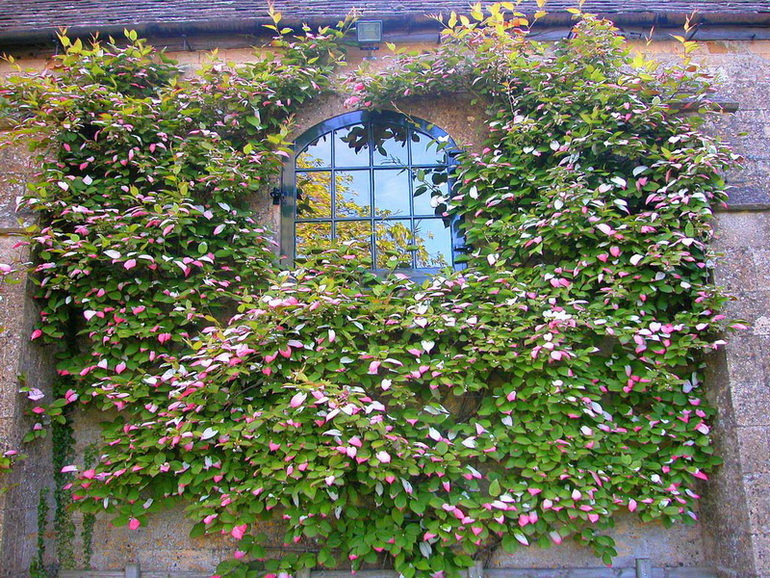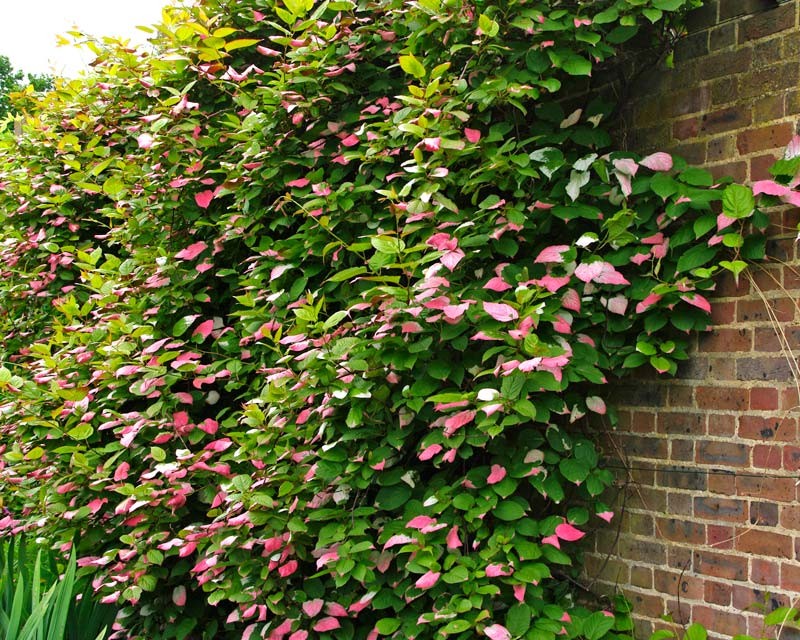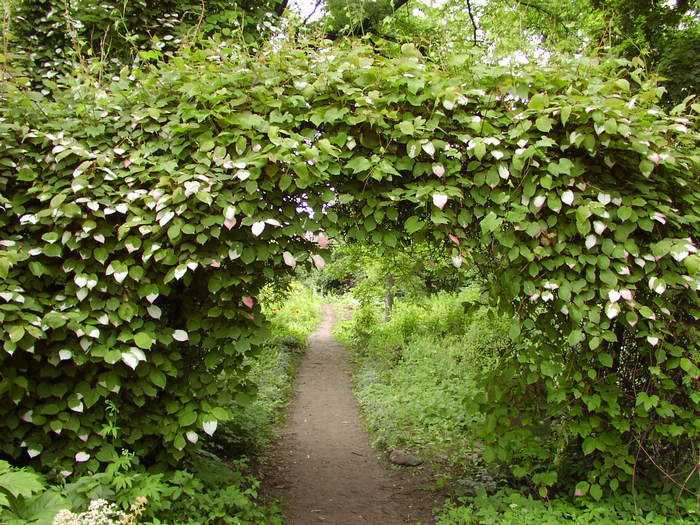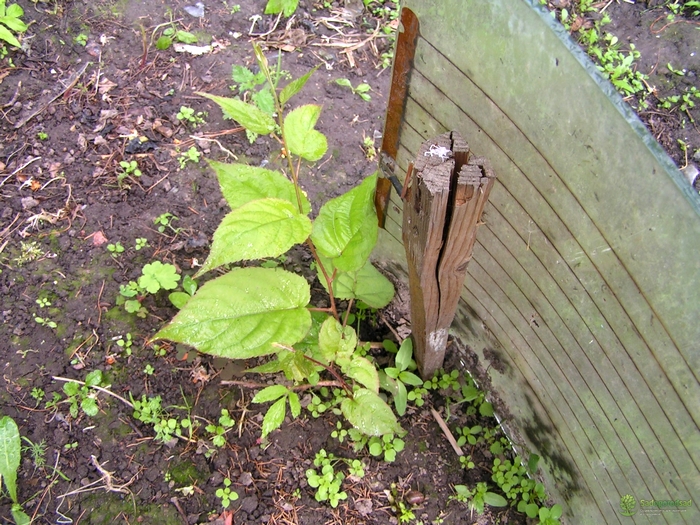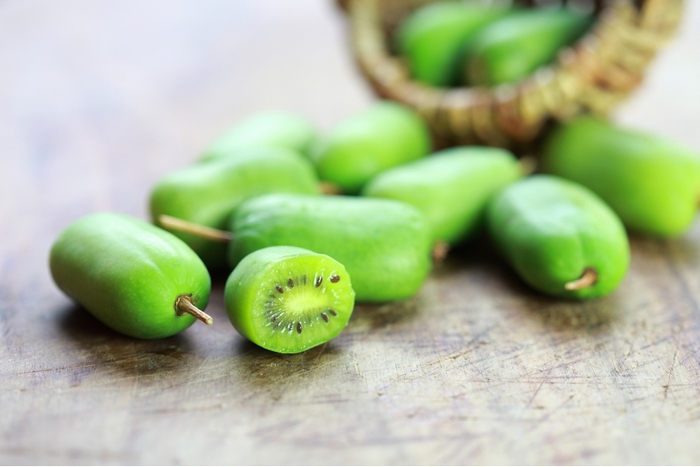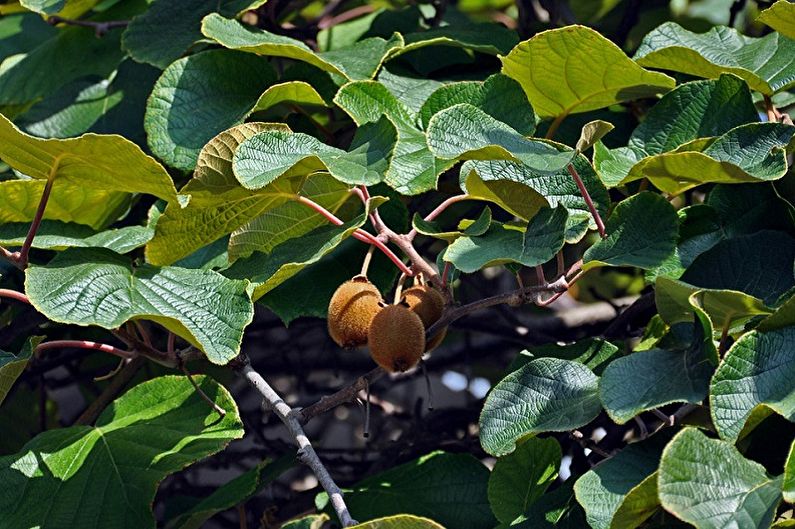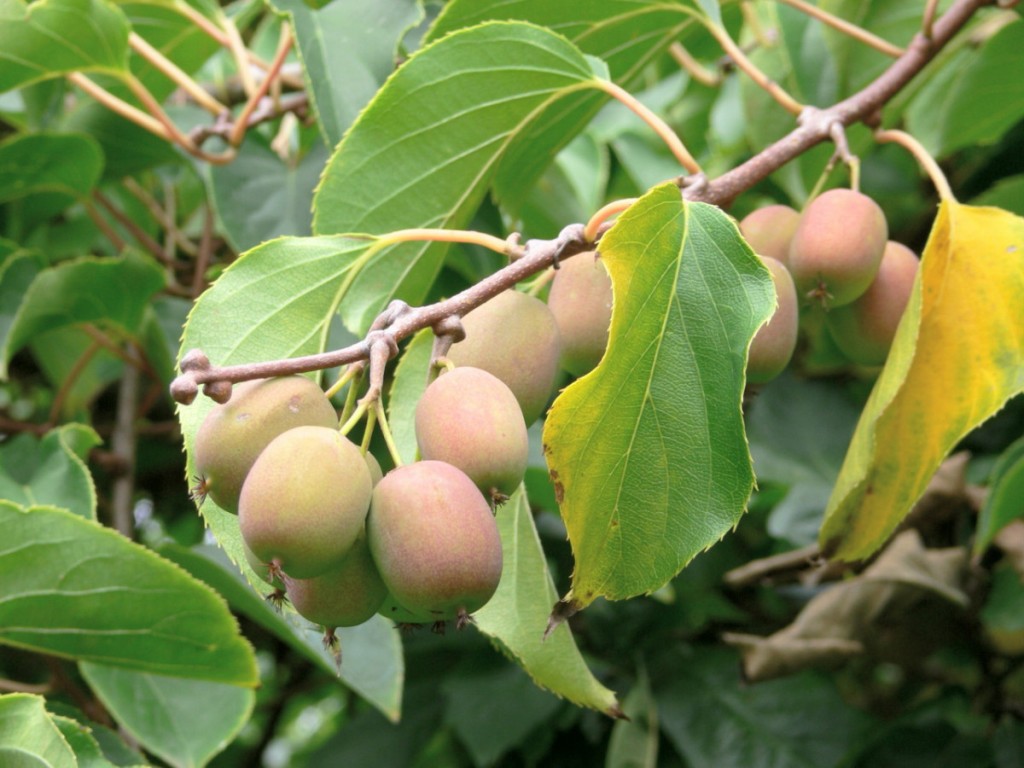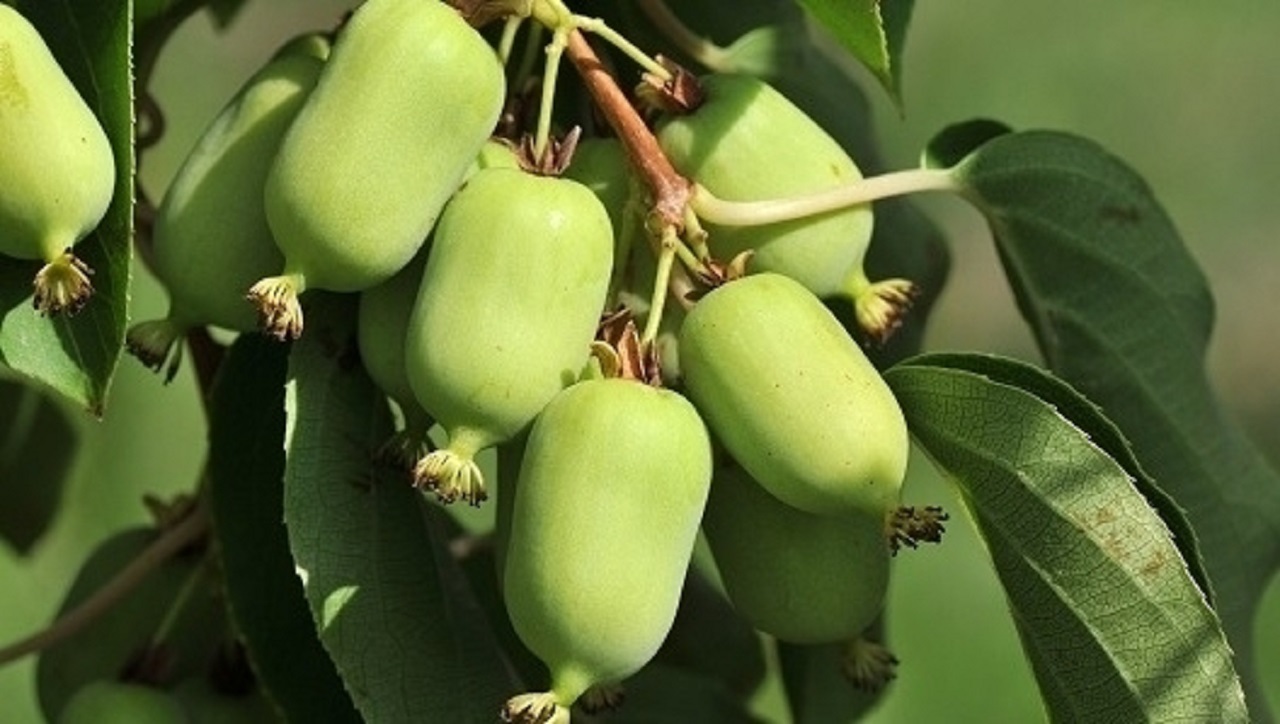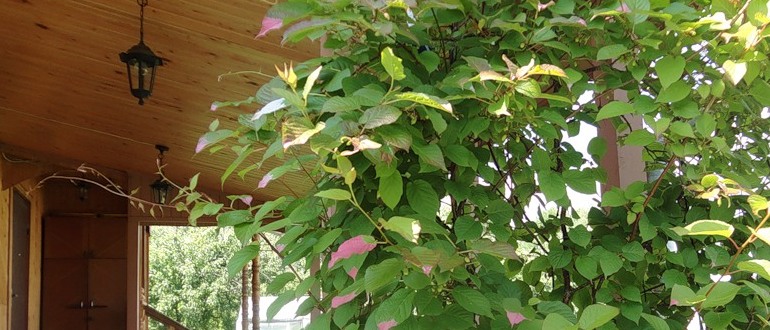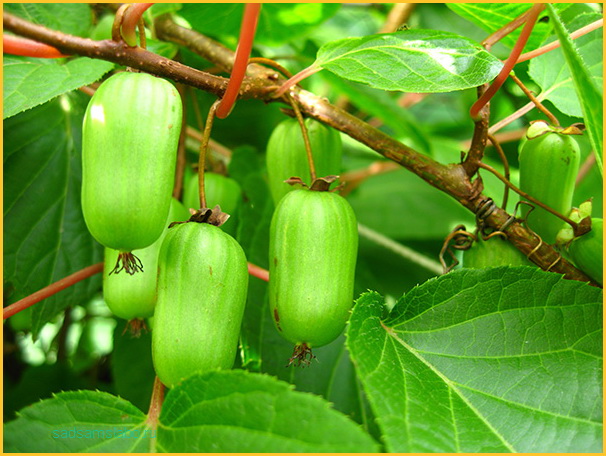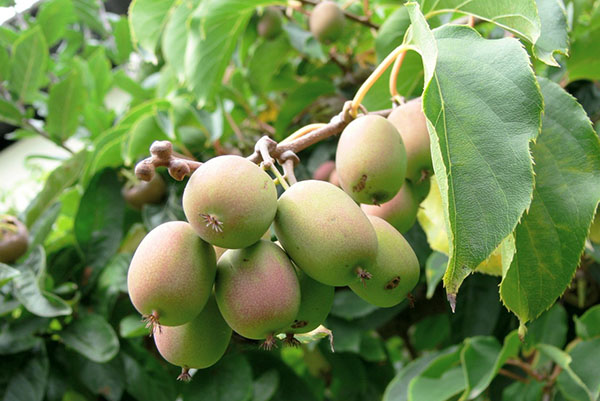Content:
Actinidium kolomikta (actinidium kolomikta) is a very beautiful climbing liana. It can serve as a garden decoration. Also, the plant is grown as a fruiting shrub. Its berries are healthy and tasty. They resemble grapes. Because of this similarity, the culture is also called the northern grape. Actinidia Kolomikta grows well in areas with short and cool summers.
Description and winter hardiness
Perennial shrub liana actinidia is a winter-hardy culture. She tolerates winters without problems. She is not afraid of frost down to -40 degrees. The plant loves the Moscow, Moscow region climate. It is grown throughout the European part of Russia, in the northern regions, where the winter is severe. Prolonged cold snap in spring and autumn does not destroy the plant.
Additional Information. Actinidium kolomikta is considered to be a long-liver among shrubs - the plant can develop for 50-100 years.
Actinidia Kolomikta is a tree-like vine. Just like the Argut type of actinidia, kolomikta cannot develop normally if there is no support. The length of the plant is 10-13 meters. Liana is constantly reaching up. The shoots twine around the stick, pillar, arch, trellis counterclockwise.
The culture has a strong trunk, the diameter of which is 4-6 cm. Branches grow from it. Their color is brown. Some of the shoots are curly, some are straight. Because of this feature, actinidia Kolomikta looks very beautiful and voluminous in the garden or on the wall of the house.
Another unique feature of the berry culture is that its leaves can change color in a few months. They are bronze in spring, emerald in summer. When whitish flowers appear in mid-June, the leaves turn white. In autumn, the leaves of the creeper turn pink. Reproduction of the culture by means of seeds or cuttings is allowed. The second way is more efficient.
The plant has very tasty fruits. Harvested at the end of September. The berries are oval in shape, 2 cm long. Weight - about 2 grams. The color is dark emerald. There are stripes. The taste is sweet, there is a slight sourness. There is a pineapple flavor. You can collect 2 kg of berries from a bush.
Important! The actinidia fruit contains nutrients and vitamins. There is a lot of ascorbic acid. 2 berries contain the daily intake of vitamin C for an adult.
Varieties of actinidia Kolomikta
Waffle
This variety is considered one of the best for cultivation in the Moscow region. He's early. The harvest ripens by August. A distinctive feature is the strong fruity aroma of the fruit. Pollinators are needed to harvest.
Magpie
The variety is distinguished by a high content of vitamin C in fruits. Usually actinidia berries contain from 1500 to 1700 mg of ascorbic acid per 100 g. In Forty it is 2200 mg. However, the taste of the fruit is still sweet, there is no bitterness.
Queen of the garden
This is an early culture. The fruits ripen in the first week of August. The berries are large. Length - about 3-3.5 cm, weight - 2.5-3 g.
Gourmet
The fruits have a thin skin. They are large, oval. They have a pronounced pineapple aroma, like the berries of the Dr. Shimanovsky variety. The taste is sweet, rich.
Large-fruited
The largest berries are in the kolomikta large-fruited variety. One fruit weighs 4.3 grams. The taste is sweet and sour. The flavor is reminiscent of kiwi. Berries tend to crumble.
Commander
It is a pollinator. The variety itself can sometimes produce a crop.The berries are tasty, juicy, but they contain a lot of seeds. Good landing areas are Moscow, the Urals.
Adam
Its distinctive feature is the lemon scent of flowers. The cultivar is a pollinator.
Additional Information. The kiwi fruit is also a species of actinidia that grows in southern countries.
Actinidia male and female: differences
The plant is dioecious. There are female and male specimens. To obtain a harvest, several varieties must be present on the site. Distinguishing male and female plants is not difficult. This should be done during the flowering of shrub vines.
So, the male specimen has flowers collected in inflorescences of 3 or 5 pieces. Many stamens can be seen in the flowers. The pistil is missing.
The flowers of the female plant have one flower on elongated petioles. They have stamens and one large pistil.
Note! No more than 4-5 female plants can be planted on one male plant. Otherwise, it will negatively affect the harvest.
How to choose seedlings
- Three-year-old seedlings are suitable for planting;
- It is best to buy a plant with a closed root system;
- You need to look after the goods in proven nurseries or special stores;
- If a seedling is purchased on the market, there is a risk of getting the wrong variety that you wanted;
- You cannot buy seedlings with damaged roots;
- There should be no signs of disease on the shoots;
- The top of the plant must be intact. You do not need to buy seedlings with cut off tops.
Landing rules
Planting crops in open ground in spring and autumn is allowed. If you do this in the fall, then a September day is suitable, when there are several weeks left before prolonged frosts. If you plant a culture in the spring, then it is best to select the first weeks of May, until the buds have blossomed.
A permanent place for the plant is chosen where the sun shines moderately, there is partial shade. The culture does not like stagnant water, so it should be removed from places where groundwater accumulates.
Actinidia Kolomikta prefers loose, light sandy soil or light loam. The earth must be slightly acidic.
Planting process
A few days before planting, a hole is dug 50-60 cm deep. The diameter is 60-70 cm. Drainage and stones are laid out at the bottom. Next, fertile soil is poured, fertilized with humus, superphosphate, potassium sulfate. A mound is formed from it.
Important! In the hole where the actinidia will be planted, you should not add lime, manure.
After one or several days, the mound will shrink a little. Then ordinary soil without fertilizers is put on it in a thin layer. Everything is now ready to plant. The seedling is placed in a hole in such a way that the roots grasp the mound, the root collar is at ground level. The roots are covered with soil mixture.
A groove is made for water. Watering is in progress. One bucket of water is enough for one plant. Further, the area under the bush is mulched. Foliage, sand, peat will do. The distance between bushes of different varieties should be from 1.5 meters or more.
Caring for actinidia Kolomikta
The culture does not require special care. You can rarely water the actinidia vine - once every few weeks. She does not like too wet soil. One shrub requires one bucket of water. If the weather is dry, then the frequency of watering is increased to once every 7 days.
Shrub mulching is necessary. Every 1.5 months, the layer of sand or peat is renewed. Before wintering, the mulch is completely changed.
Actinidia Kolomikta needs support. You can plant actinidium near your home or near a fence. In this case, the twigs themselves will find something to catch on to. If the plant is not near the structure, you can put a trellis, arch, and various frames next to it.
The plant develops rapidly, it needs pruning. The procedure is carried out only after the bush is 4 years old. Before this period, pruning is not carried out. Formative pruning is carried out annually, mainly during the warm summer months or autumn. Gardeners should do anti-aging pruning every 10 years.
Note! The variety is not susceptible to pests. Insects prefer to stay away from actinidia. Owners do not need to buy expensive pest control products.
Preparing for winter
If the dacha is located in a region where the winter is not too harsh, then in the fall the bush is simply mulched with rotted sawdust and peat. If the winter is cold, then the vine is removed from the support and placed under the shelter. Lutrasil, spunbond can act as a shelter.
Actinidia Kolomikta, planting and caring for which is quite simple, is a very unusual and beautiful plant. For Russia, this is a new culture that has recently become fashionable. Liana will decorate the garden, and will also yield sweet fruits. Various desserts, jams, jellies are prepared from berries.
